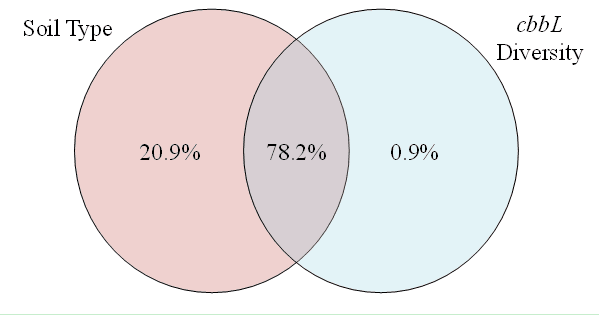Comparison of Soil Carbon Fixation Rates and Autotrophic Population in Three Natural Ecosystems in China
Soils contribute to the terrestrial carbon cycle either as a source or sink for carbon. CO2 assimilation by autotrophic microbes is an important process in soil carbon cycling that reduces atmospheric CO2 concentration, which could mitigate the current global warming threat. CO modulates the oxidative state of the atmosphere and greenhouse gas concentrations. Aerobic CO-oxidizing bacteria consume approximately 15% of annual CO emissions, indirectly altering the tropospheric chemistry of greenhouse gases. CO-dehydrogenase, whose large subunit is encoded by coxL, enables microbes to utilize CO as a sole source of carbon and energy.
Although CO2 assimilation by autotrophic microbes is an important process in soil carbon cycling, people's understanding of the community composition of CO2 fixing bacteria and CO-oxidizers in natural soils and their role in carbon sequestration of these soils is still limited. Therefore, the research group from the Institute of Subtropical Agriculture, Chinese Academy of Sciences (ISA) performed continuous labeling of three typical natural soil types (Wetland, Grassland and Forest) with 14C-CO2 for 15 days. They hypothesized that the physiological strategies for autotrophic microbial growth in these soils vary depending on biogeochemical factors. After 15 days of continuous labeling, the researchers measured the amount of labeled C incorporated into the microbial biomass in these soils. They also evaluated the diversity and abundance of CO2-fixing and CO-oxidizing bacteria by molecular analysis of cbbL and coxL genes, and used this information to estimate the genetic potential of microbial carbon fixation in each ecosystem. They also examined soil physicochemical properties to identify key factors shaping the microbial diversity in these soils.
The researchers found that 14C assimilation rate was nearly three times higher in wetland soil than in grassland and forest soils, with a two magnitude difference in cbbL gene abundance. They observed that correlations between the differences in soil properties and the abundance of the cbbL gene confirm that autotrophic bacterial abundance is dependent on soil type (Fig. 1).
They also observed that some bacterial species were common to both communities by comparing the cbbL and coxL phylogenetic trees and the RDA showed that each soil type contained distinct communities of bacteria harboring cbbL or coxL, with C/N ratio and EC being the major determinants of the community structure. They concluded that the positive correlation among 14C-MBC, 14C-SOC synthesis rate, and cbbL gene copy number highlights the important role of autotrophic bacteria in C-sequestration in natural soils.
This study entitled "Soil carbon-fixation rates and associated bacterial diversity and abundance in three natural ecosystems" has been online in Microbial Ecology (DOI: 10.1007/s00248-016-0890-x). The reviewer comments " The results provide insight into the ecological roles of the soil autotrophs in soil CO2 dynamics and CO-oxidizing communities in natural soils." The full-text can be downloaded at http://link.springer.com/article/10.1007/s00248-016-0890-x
This study was supported financially by the National Natural Science Foundation of China (41522107; 41503081), Key Projects of International Cooperation in Science and Technology Innovation (S2016G0053), Strategic Priority Research Program of the Chinese Academy of Sciences (XDB15020401), and Royal Society Newton Advanced Fellowship (NA150182).

Fig. 1 Effect of Soil Type and CbbL-carrying Bacterial Diversity on 14C Fixation Rate in Three Natural Ecosystems
Download attachments: